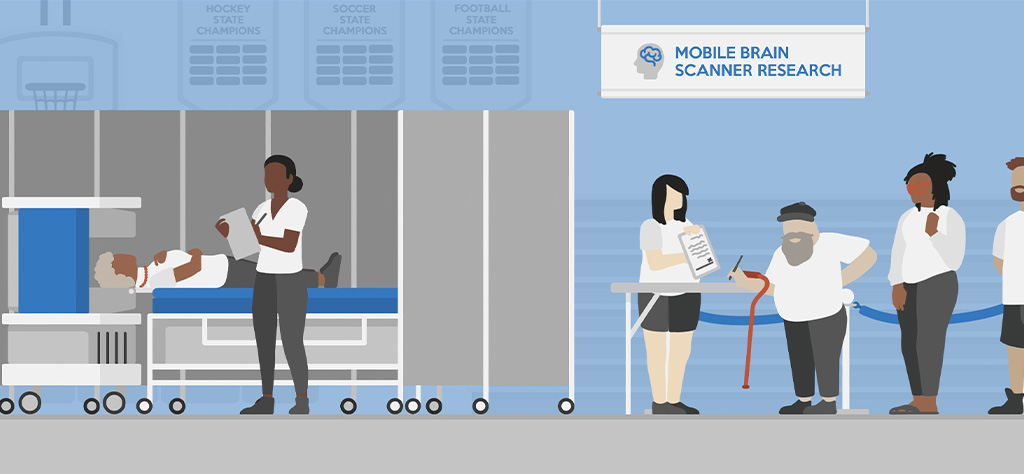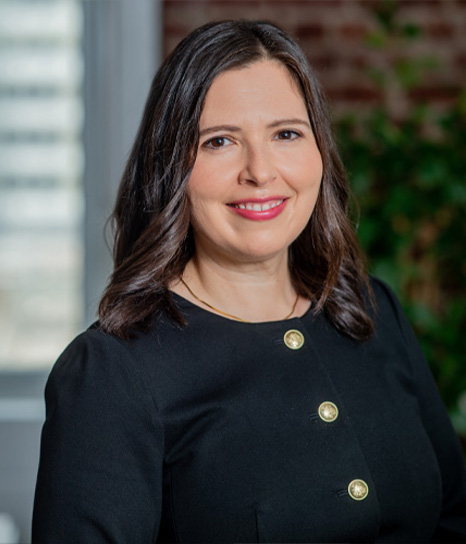News & Insights
Putting Ethical Guidelines in Place for Portable MRI Research


Illustration of how a portable MRI system might be deployed for field-based research in a school gymnasium. Image credit: Alexis Kocken.
Magnetic resonance imaging (MRI), a radiologic imaging technique that uses a combination of magnetic fields and radio waves to generate images of organs inside the body, has provided neuroscientists with a unique window into the living brain, revolutionizing the field’s understanding of both the brain’s structure and function.
Over the past 40 years, thanks to advances in physics and engineering, improvements in contrast and resolution in such images have made functional MRI an indispensable tool for laboratories across the globe. With the ability to measure metabolic changes in the body, including cerebral blood flow, over time, researchers could better understand normal brain activity and how that activity changes in people suffering from brain-based conditions. Yet, the enormous size and expense of such scanners meant that access was only available to those working in well-funded universities and large academic medical centers.
Recently, companies such as Hyperfine have developed highly portable MRI, or mobile neuroimaging units that can be transported nearly anywhere with a standard electrical outlet. Khara Ramos, Ph.D., vice president of Neuroscience & Society at the Dana Foundation, said this is an exciting prospect—as the smaller and more affordable “magnets” have the power to democratize neuroscience research. Researchers who may not have had access to neuroimaging technologies can now use MRI and collect brain data from more diverse participant populations.
“The ability to give people access to technology along these lines outside of established, well-resourced academic institutions opens up an exciting range of possibilities,” Ramos said. “Yet, they are not the same as the kind of MRI machines you find in bigger institutions. That raises concerns—and it’s important those concerns are addressed.”


Francis X. Shen, J.D., Ph.D.
Because of those concerns, a national, multidisciplinary working group, led by researchers based at the University of Minnesota, published key guidance in the Journal of Law and the Biosciences to address the ethical, legal, and policy challenges of the kind of field-based research that highly portable MRI will allow. Francis X. Shen, J.D., Ph.D., a professor of law who works at the intersection of neuroscience and that law firmly believes that “every story is a brain story.” Shen said that he was inspired to put together this working group when he first learned about advances in portable MRI because he wants to see this new technology “flourish.”
“This new technology has so much potential,” he said. “That’s why it’s so important to have the right ethical guardrails in place to help it succeed—and help it do so for as many people as possible.”
Considering a New, Mobile Brain Imaging Option
Michael Garwood, Ph.D., associate director of the Center for Magnetic Resonance Research at the University of Minnesota has been working to “push the limits” of what MRI scanners can do for the bulk of his 40-year career. Over the last decade, however, he has changed gears, looking for ways to increase MRI access to those outside of large academic institutions.


Michael Garwood, Ph.D.
“MRIs are so powerful and are such a huge tool for research,” he said. “But there’s no way to get it out to the underserved and to study people in remote areas. So much of what we know about the brain has been learned from graduate students who volunteered to be participants in studies. It’s important to have a more heterogenous data set.”
Finding ways to make a smaller, portable magnet that can provide good images, he added, is also a “wonderful physics problem.”
After receiving a National Institutes of Health (NIH) Brain Research Through Advancing Innovative Neurotechnologies (BRAIN) grant to work on a portable MRI scanner, Garwood received an unexpected call from Shen.
“He asked if I knew that the BRAIN grants had supplement opportunities for ethical issues related to the brain tools [my group was] developing,” Garwood said. “I had—but I thought, for MRI, what are the ethical issues? We’re just going to be able to help people if we succeed.”
Shen proceeded to list some of the issues to Garwood, starting with training inexperienced researchers on the new technologies and moving to data privacy concerns. That got Garwood’s attention—and inspired him to apply for one of the grant supplements.


Ben Parkinson (left) and Michael Garwood with the Portable 1.5T MRI system technology. Photo courtesy of Garwood.
With funding in place, Shen recruited a multidisciplinary working group, consisting of members with expertise in neuroscience, radiology, research ethics, neurology, artificial intelligence (AI), neuroimaging, community engagement, and law. Together, the group would analyze the host of potential ethical, legal, and societal issues that could arise with the use of highly portable MRI and develop usable guidance for its future use in research projects. Those issues ranged from engaging diverse participants for research studies to interpreting and communicating the meaning of portable MRI data.
“We wanted to make sure we had a really diverse and representative group,” said Shen. “We have both clinicians and researchers, even though our scope focused on research. There are neuroscientists and physicians. There are lawyers and ethicists. There are people who do empirical work, and those who are more familiar with qualitative work. We also have diversity in terms of race, ethnicity, and gender. We thought this was all directly relevant to the success of the project, especially as we were asking people to stretch outside the traditional confines of their expertise, engage with this new technology, and consider all the potential issues.”


Jonathan Jackson, Ph.D.
Jonathan Jackson, Ph.D., executive director of the Community Access, Recruitment, and Engagement (CARE) Research Center at the Massachusetts General Hospital and Harvard Medical School, who served as a member of the working group, said one of the challenges is that highly portable MRI offers neuroscientists a chance to “go where the scientific questions are.”
“The use of this technology means moving from a highly controlled experimental environment to one that is basically uncontrolled,” Jackson said. “That means we need strong guidelines in place to make sure that research done with these new technologies is high-quality, inclusive, and that the data coming from such studies is appropriately interpreted.”
Whittling Down the Recommendations
The working group met ten times over the course of three years, with the goal of building consensus on key guidelines around portable MRI use. The group came up with 15 recommendations to address the ethical, legal, and societal issues, subdivided into categories regarding establishing competencies; ensuring oversight; engaging and recruiting diverse and representative participant populations; protecting research participants; using AI; interpreting and communicating the meaning of scans to participants; promoting quality control; ensuring data privacy and security; managing incidental findings; and facilitating participant access to data.
Shen said that coming up with guidelines regarding training and safety was fairly straightforward. Everyone agreed that it was important that those interested in using portable MRI should establish competencies before scanning—and were adequately trained before starting their research projects. But concerns regarding data governance were somewhat thornier.
Donnella Comeau, M.D., Ph.D., a neuroradiologist at Mass General Brigham (MGB) and member of the working group, said, as vice chair for the institutional review board (IRB) at her own institution, she thinks a lot about AI and where data may travel and be stored. Given the low resolution of highly portable MRI, systems need AI to augment the images at the time of acquisition or during post-processing.


Donnella Comeau, M.D., Ph.D.
“It’s important that these algorithms use data that is diverse and generalizable. It’s a big issue—and one that people in AI are already dealing with,” she said. “And then you need to think about the security of the data from these scanners. Some of the sites where portable MRIs will be used might not have great web capabilities. So how will they transfer data safely and securely? This is also going to be a big issue for people who are processing the images.”
Comeau also has concerns about the researchers who are reading the images. One of the advantages of highly portable MRI is that social scientists, or even citizen scientists, will now be able to conduct research projects. But will they be able to identify a potential serious incidental finding, such as a brain tumor, without the consultation of a radiologist? Researchers have a responsibility to let participants know if they find something that could impact the participant’s health.
“We already have a shortage of radiologists,” she said. “And, for someone who doesn’t have training to read these images, they may miss something important.”
Preparing for a Portable Brain Science Future
Garwood said he is excited by the idea of researchers being able to bring MRIs to patients. He cited a new grant he and his colleagues have submitted to bring portable MRIs to reservations to better understand why Native Americans are more prone to developing dementia.
“This kind of technology is going to be beneficial to people who have been so often excluded from research just because of their geographic location,” he said. “There’s such high prevalence of dementia in Native Americans. Why? Now we can bring a scanner to the people 200 miles outside the Twin Cities to do the research we need to do. We can start trying to answer these questions and get this kind of work done.”
Yet, Ramos added, it is important that the availability of portable MRI doesn’t lead to “two tiers of scientific possibility.”


Khara Ramos, Ph.D.
“The powerful magnets you find in academic institutions give you such exquisite detail,” she said. “The portable, low-field stuff is more limited in the kind of images they can provide. So, while these new technologies can democratize access, it’s important that people understand its different types of access—and that needs to be taken into account when we look at any results.”
Jackson agreed. And said he hopes the guidelines the working group developed will raise awareness about what highly portable MRI can and can’t do.
“Whenever we come up with new technologies, especially new brain technologies, they are often used to falsely reinforce societal biases. Pretty much every emergent neurotechnology has fallen into this trap,” he said. “We should expect that something similar will happen here because it usually does. But, hopefully, the recommendations we developed are designed to limit that impact or at least raise awareness about any possible misuse before it happens.”
Introducing Ethics Early and Often
Beyond the advent of highly portable MRI, Ramos said that she hopes that others who are developing new neurotechnologies will start to explore the ethical implications of their work early in the development process.
“Far too often, scientists—even if they recognize there are ethical, legal, and societal implications of their work—aren’t sure what to do about it,” she said. “Having the infrastructure and support to explore these issues, systematically engaging with collaborators, can really support the advancement of neuroscience in alignment with societal goals and human values.”
Garwood, for his part, agreed. He said that he believes that all scientists and engineers building tools for the brain benefit when they start considering the ethical issues of their designs from day one.
“I’m a physicist. I was focused on the engineering and the physics it would take to make a portable MRI work,” he said. “But now I know, especially if you are developing something that has the power to probe something about the brain, you better start early thinking through the ethics and the legal implications if you think you have any chance of succeeding.
Without your bioethics people to help you get on top of the issues, you can develop the greatest tool ever, but it may never get deployed because it won’t benefit society if it isn’t built in the right way.”
Featured illustration by Alexis Kocken


